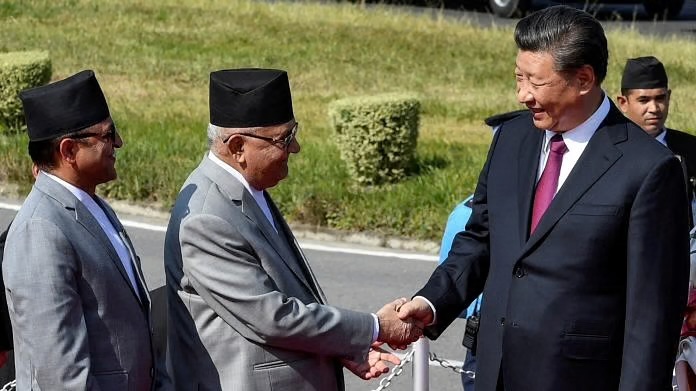Why India Shouldn't Worry About Oli's China Move—Nepal Knows Its Limits
Nepal Prime Minister KP Sharma Oli’s Strategic China Visit Raises Regional Concerns

Rishi Gupta
Nepal Prime Minister KP Sharma Oli’s visit to China, scheduled from December 2 to December 6, 2024, is his first foreign trip since assuming office in July 2024. Traditionally, newly elected Nepali leaders make their maiden visit to India, reflecting the deep-rooted ties between the two nations. However, Oli’s decision to prioritize China signals a potential strategic shift, sparking interest and concern in Delhi.
For Nepal, a nation nestled in the foothills of the Himalayas, this visit carries significant geopolitical weight. India, often cautious about its neighbors’ foreign policy decisions, views such moves with apprehension, interpreting them as threats to its regional influence. The critical question arises: is this just another step in Nepal’s evolving foreign policy, or does it signal a transformative realignment?
Prime Minister Oli has long been recognized for his pro-China stance. His party, the Communist Party of Nepal-Unified Marxist-Leninist (CPN-UML), has historically criticized India, particularly during the 2015 border blockade, accusing Delhi of interfering in Nepal’s internal affairs by supporting Madhesi protesters who opposed the newly implemented constitution. The blockade led to a surge in ultra-nationalistic and anti-India sentiments in Nepal, which culminated in the introduction of the country's first National Security Policy in 2016. This policy identified “open borders” and “border encroachment” as key external threats, underscoring a shift toward diversified ties with China.
Oli first visited China as Prime Minister in March 2016, shortly after taking office in October 2015. During this visit, he sought to bolster cross-border connectivity, including using Chinese ports for third-country trade—an attempt to reduce Nepal’s dependency on India. China, in turn, seized the opportunity to deepen its strategic ties with Nepal, a relationship that Beijing has cultivated since formal diplomatic relations were established in 1955. Nepal’s geographical proximity to Tibet and the presence of thousands of Tibetan refugees have made Kathmandu crucial to China’s security interests. Moreover, reducing India’s influence in Nepal would represent a significant strategic win for Beijing.
In May 2017, Nepal signed onto China’s ambitious Belt and Road Initiative (BRI), envisioning major infrastructure investments like the Trans-Himalayan Multi-Dimensional Connectivity (THMDC) Network to link Kathmandu with Tibet. However, seven years later, no substantial progress has been made. Feasibility studies have stalled, and Nepal remains cautious about high-interest Chinese loans, fearing a debt trap. For instance, the Pokhara International Airport, constructed with a $188.89 million loan from China’s Exim Bank, has failed to generate significant international traffic, prompting Nepal to request Beijing to convert the debt into a grant.
Nepal has traditionally preferred grants over loans due to its limited industrial resources and economic capacity. India has consistently provided grants, particularly during the 2015 earthquake reconstruction and in health and education infrastructure. While China has encouraged Nepal to identify BRI projects, Beijing may now focus on smaller, low-budget initiatives to minimize financial risks.
In 2020, Nepal reached an agreement with China to use four Chinese seaports for third-country trade. However, the ports are about 3,000 kilometers away, compared to the 700-kilometer distance to India’s Kolkata port, which remains well-connected and easily accessible. As a result, no shipments have been moved under the agreement, further questioning the feasibility of Nepal's economic engagements with China.
Nepal and China have also strengthened security ties, conducting joint military exercises under the Sagarmatha Friendship series, focusing on disaster relief, counter-terrorism, and high-altitude warfare. While these exercises have raised concerns in India, China’s ambitions extend beyond defense. Since Chinese President Xi Jinping’s 2019 visit to Nepal, Beijing has been pushing for an extradition treaty, which would enable it to repatriate Tibetan refugees living in Nepal. However, such a treaty faces resistance from human rights organizations and international actors like the United States, which recently granted Nepal $500 million under the Millennium Challenge Corporation.
China remains eager to deepen its strategic cooperation with Nepal, viewing the country as a critical component of its broader geopolitical objectives. Yet, its achievements so far have been limited to political symbolism rather than tangible benefits. Nepal’s deep-rooted cultural and geographical ties with India, coupled with skepticism toward Chinese investments and loans, have constrained Beijing’s influence.
Recognizing these challenges, China has shifted its focus toward fostering goodwill. A recent example is Beijing’s decision to waive visa fees for Nepali citizens, encouraging greater people-to-people engagement. While this may enhance public perception, it is unlikely to replace the longstanding ties Nepal shares with India.
Prime Minister Oli’s visit to China reflects Nepal’s ongoing effort to balance its foreign relations. However, whether this visit results in significant policy shifts or remains a symbolic gesture will depend on Kathmandu’s ability to navigate its complex relationships with India and China.
Rishi Gupta is the Assistant Director of the Asia Society Policy Institute, New Delhi. He writes on Asia-Pacific affairs, strategic issues in the Himalayas, and South Asian geopolitics. He tweets @RishiGupta_JNU. Views are personal.




![From Kathmandu to the World: How Excel Students Are Winning Big [Admission Open]](https://nepalaaja.com/img/70194/medium/excel-college-info-eng-nep-2342.jpg)
